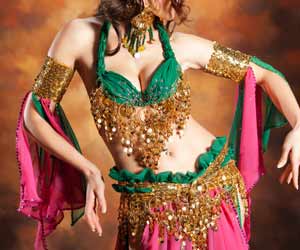Learning Belly Dancing and Flamenco
Belly Dancing
Belly dancing originates from the Middle East and parts of North Africa, and is considered to be a feminine, flowing kind of dance. There are many forms of belly dancing, each specific to the country and region of origin. There are two specific types; Raqs Sharqi, or “oriental dance”, which is the type that is performed in restaurants and cabarets, familiar to most Westerners, and Raqs baladi, which means “dance of the country”, which is a folkloric style dance socially by both men and women at festive occasions, such as weddings.
There are many theories on how and why belly dance evolved, but the most popular theory is that it was originally used by women in Iran, India and North Africa to ease childbirth. Belly dancing grew in popularity during the 18th and 19th centuries, when popular art romanticized harem life in the Ottoman Empire. It gained mainstream cultural recognition when dancers began to perform at World’s Fairs.

Belly dancing lessons teach the basic belly dance techniques, such as the hip and shoulder shimmy, (a quick back and forth vibration), snakelike undulations of the body, hip punches, and expressive arm movements that are used to frame the body during the dance. To learn belly dancing, a dancer focuses on body isolations, learning to move different body parts separately from the rest of the body. Although the focus is on the hip and pelvic area, the entire body is used. Belly dancing is non-impact and wonderful for developing core strength and grace, making it a suitable form of dance for all ages.
Belly dancing costumes are a fun part of becoming a belly dancer. Although there are many different styles of costume, the most popular is the bedlah style, which consists of a belly dancing bra, a wide hip belt or hip scarf, and a belly dancing skirt or harem pants. Many belly dancing belts and scarves are quite ornate, decorated with beaded fringe or coins that move and jingle during the dance. Belly dancing bras are often quite elaborate as well. Other props used are: finger symbols (called zills or sagats), belly dance veils, and belly dance scarves.
Flamenco Dancing
Flamenco dancing is a type of Spanish dancing that originated in Southern Spain, in the region of Andalusia. The dance is known for its key elements of emotional intensity, proud carriage and expressive body and arm movements. Flamenco music and dance is central to the social culture of the Andalusian gypsies, and can be seen in its purest forms at gypsy weddings and social celebrations.
During the late 18th and early 19th centuries, flamenco dancing became a popular public attraction in numerous cafes cantantes, and then later in larger venues and theater productions. However, a traditional flamenco fiesta is usually quite small and very organic in nature- no one is exactly sure when it will begin and end, or even who will show up.

Flamenco music is the backbone to flamenco dance, with the two intertwining in an ongoing conversation. Styles of flamenco music are called “palos”, and range from quite serious to lighthearted and frivolous, but all share the common denominator of emotional intensity. The tempo is created by a fusion of acoustic guitar, singing, chanting, staccato handclapping, and rapping with knuckles on a table or the guitar.
Dancers begin to dance after first listening to the music and becoming inspired. What follows is an improvisational dance consisting of a rhythmic stomping of the feet (often with lightning-fast footwork), expressive, flowing arm movements, spins and twirls. Flamenco dancers often use props such as castanets, shawls and fans to add detail and a personal flair to their dance. Flamenco dance dresses are often worn in dance performances today, but they originated from the Spring Fair in Seville, and are not purely traditional costumes. Flamenco dancing shoes often have nails driven into the heels and toes to provide an additional acoustic element to the rhythm and the dance.
Flamenco dance is known to be highly technical and its precise movements require years of study to perfect. It is believed that a young dancer has not yet acquired the emotional maturity to feel and express the intense emotions of the dance, so many dancers do not reach their peak until their thirties and continue to perform well into their fifties and beyond.

